


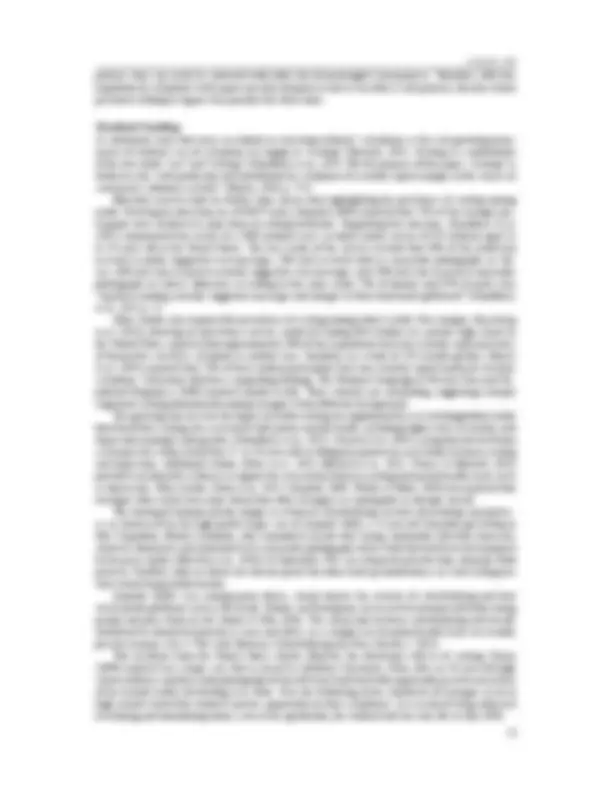
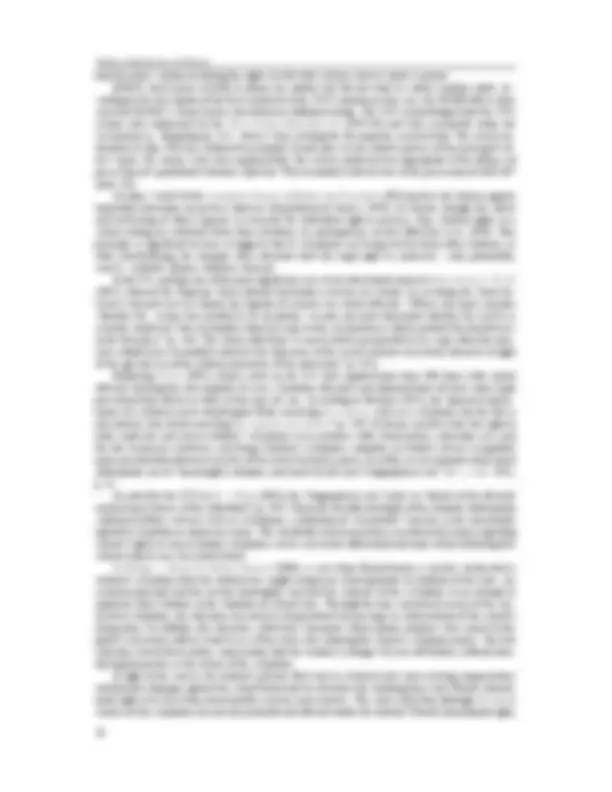
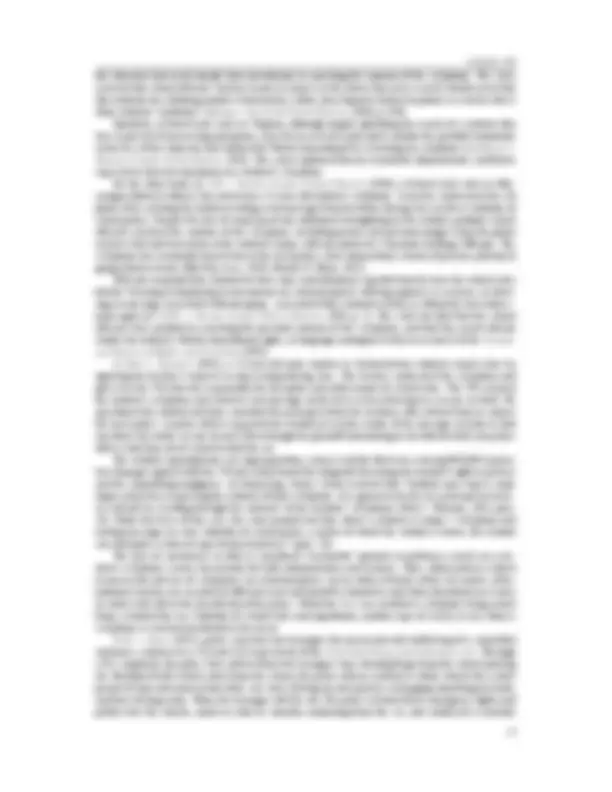
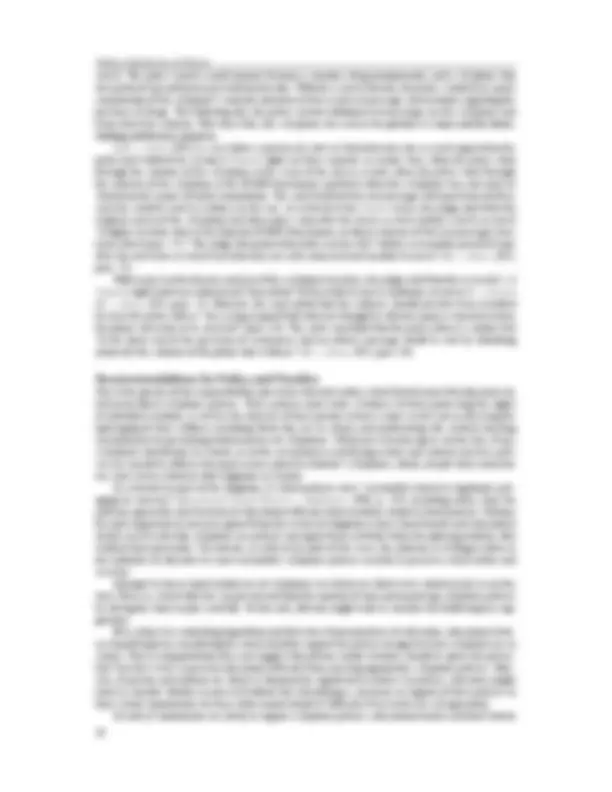
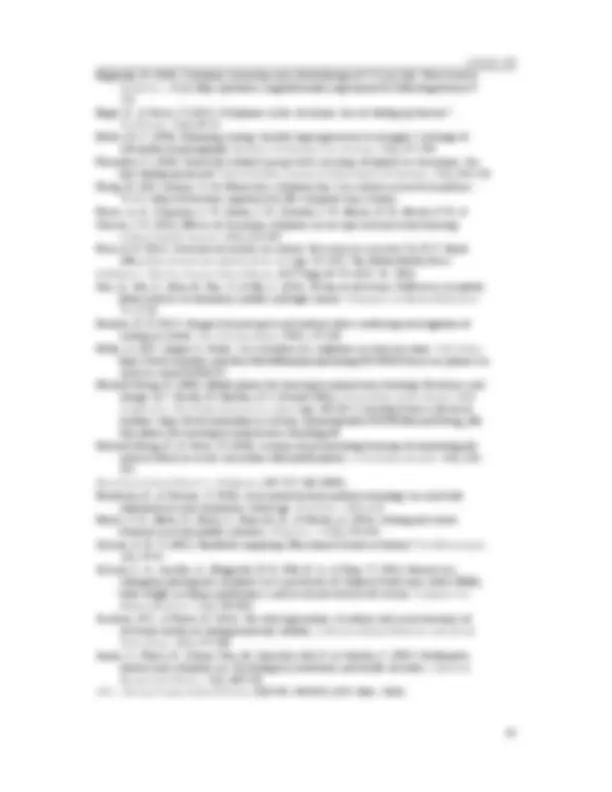
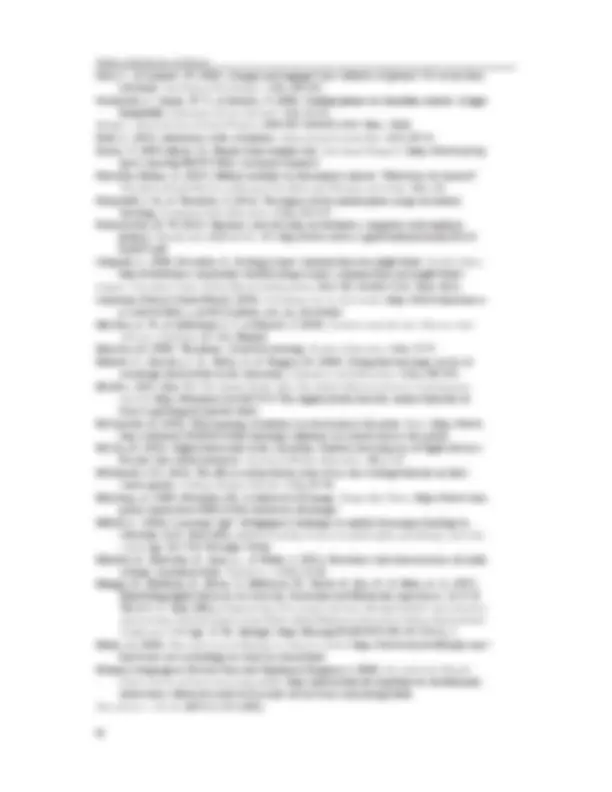
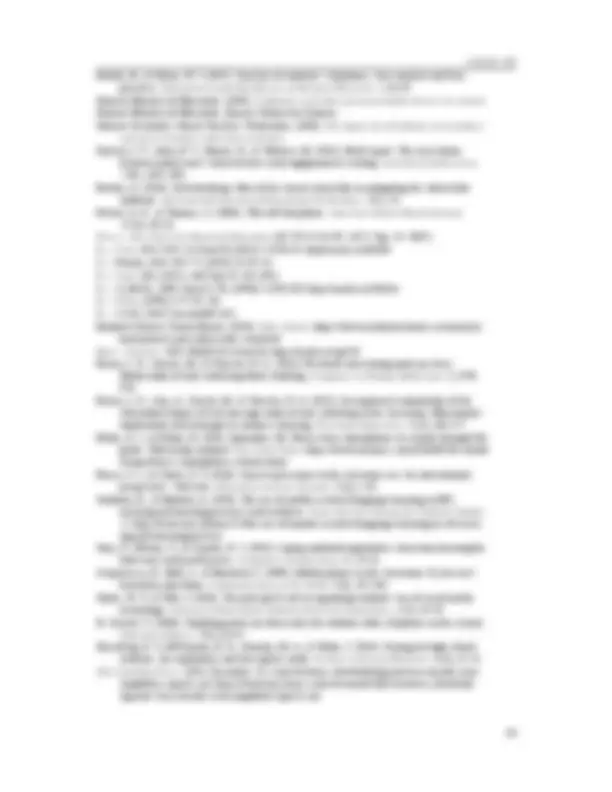


Study with the several resources on Docsity

Earn points by helping other students or get them with a premium plan


Prepare for your exams
Study with the several resources on Docsity

Earn points to download
Earn points by helping other students or get them with a premium plan
Community
Ask the community for help and clear up your study doubts
Discover the best universities in your country according to Docsity users
Free resources
Download our free guides on studying techniques, anxiety management strategies, and thesis advice from Docsity tutors
This paper reviews the literature and litigation on cell phone use in schools due to controversies over cheating, cyberbullying, sexting, and searches of ...
Typology: Exercises
1 / 16

This page cannot be seen from the preview
Don't miss anything!










Despite the potential instructional benefits of integrating devices such as cell phones into schools and classrooms, research reveals that their improper use can negatively impact student behaviour, learn- ing, and well-being. This paper reviews the literature and litigation on cell phone use in schools due to controversies over cheating, cyberbullying, sexting, and searches of student cell phones. Recent studies suggested that the presence of cell phones and related technologies in classrooms could detract from students’ academic performances while contributing to higher rates of academic dishonesty and cyber- bullying. The growing prevalence of cyberbullying is especially concerning because it can have severely negative, even tragic, effects on student mental health and safety. However, given the relatively discreet nature of cell phone use, regulations about their use can be difficult to enforce. After reviewing literature and litigation on the potential risks associated with inappropriate cell phone use in schools, this paper offers suggestions for educators to consider when devising or revising policies balancing students’ indi- vidual rights with their safety and well-being before ending with a brief conclusion. Keywords: social media, cell phones, schools, sexting, cyberbullying, search and seizure
The role of cell phones and other screen technologies in classrooms continues to generate much dis- cussion and heated debate in Canada, the U.S., and beyond. More specifically, how to best manage the increasing ubiquity of cell phones in schools continues to challenge teachers, pedagogical leaders, ad- ministrators, and policymakers alike. While there appears to be some support for integrating cell phones and related technologies into academic instruction (e.g., Blikstad-Balas & Davis, 2017; Derounian, 2017; Marcoux, 2009), the cumulative risks and detrimental effects of their use may outweigh these potential educational benefits (e.g., Beland & Murphy, 2016; Chaudhary et al., 2017; Englander, 2018; Hosokawa & Katsura, 2018). This paper explores the impact of cell phone use on student behaviour, learning, and well-being in educational contexts. Against this background, the paper examines the benefits and detriments of cell phone use in schools and the associated legal implications of e-cheating, cyberbullying, sexting, plus search and seizure for students and educators. We then suggest that in order to address these issues, school boards, provincial governments, and perhaps even the federal government must develop more nuanced and consistent up-to-date policies regulating the presence and use of cell phones and other com- munication e-devices. The article rounds out with a brief conclusion. Canadian Journal of Educational Administration and Policy , 195, 49-
Smale, Hutcheson, & Russo
In the ongoing struggle to regulate cell phone use in schools, some educators have taken a decidedly “if you can’t beat them, join them” approach. These educators maintain that cell phones can be leveraged to enhance student collaboration, engagement, and idea-sharing across grade levels and subject areas. Regarding the potential benefits of using cell phones as part of teaching and learning, Marcoux (2009) suggested that they can help to enhance student research, to connect students with school activities and events, and to facilitate teaching digital responsibility. Other suggested benefits of using cell phones include enabling modern learning, expanding learning outside of classrooms, using cell phones as al- ternatives to textbooks (Wainwright, 2012), and providing students with virtual tours to many places previously unavailable (Bain, 2015). Studies reveal that cell phone use in classrooms have an array of other beneficial effects for young people, including improving motivation, being relevant for future work, supporting pedagogical innova- tion (Ontario Secondary School Teachers’ Federation (OSSTF), 2018, p. 7), and greater interactivity in the classroom (e.g., Scomavacca et al., 2009). Mifsud (2003) stated that cell phone use has high potential for students involved in distance learning. Further, in a study of 92 preservice teacher candidates, Thom- as and O’Bannon (2013) reported that 61% of respondents reported that cell phones provided anytime or anywhere purposeful learning opportunities. Research literature has identified further benefits of cell phone use such as content creation and assessment (e.g., Hartnell-Young & Vetere, 2008), differentiation of instruction (e.g., Kukulska-Hulme, 2007), as well as reflection (e.g., Engel & Green, 2011; Markett et al., 2006). Digital cameras, video re- corders, access to the Internet, social networking, and text messaging capabilities on cell phones have also been shown to have an array of important classroom applications. For example, students can use digital cameras and video recorders to collect data for science ex- periments and to create podcasts, respectively, and teachers can use social media to post homework assignments (Thomas & O’Bannon, 2013). Moreover, a 2018 survey by the Ontario Institute for Studies in Education (cited by OSSTF, 2018), drawing on data from a representative sample of Ontario residents, found that “80% of respondents thought that schools should provide opportunities for students to become “technologically savvy” through the use of tablets, netbooks and related software” (p. 5). While many agree that school leaders must take concrete steps to educate students to understand the impact of their online behaviour and to become “technologically savvy,” researchers do not necessarily agree that having cell phones in classrooms is essential to achieve these objectives. Some studies have maintained that university students should be mature enough to control the urge to compulsively check their phones (Fernandez, 2018), and that these students will agree to significant restrictions on their cell phone use if the rules are clear (Tatum et al., 2018) or if bonus marks are offered for abstinence (Katz & Lambert, 2016). The ethics of “rewarding” students to follow cell phone policies is certainly ques- tionable, but more importantly, the relevance of these findings to elementary or even secondary school contexts is problematic at best.
In contrast to the studies suggesting the benefits of cell phones in academic environments, other stud- ies reported that cell phones have potential disadvantages for student learning. However, the in-depth research investigating the relationship between cell phone use and academic performance has received limited scholarly attention. Beland and Murphy’s (2016) study on the impact of cell phones on students’ academic performance, reported that when cell phones were banned from classrooms, standardized test scores went up approx- imately 6% on average and more than 14% for low-achieving students. The researchers observed that the ban’s differential effect on previously underperforming students is especially significant in light of school-board equity policies, as “banning mobile phones could be a low-cost way for schools to reduce educational inequality” (Beland & Murphy, 2016, p. 18). Wilmer et al. (2017) reinforced these findings, concluding that studies on this issue “generally sup- port the conclusion that poor academic performance (generally assessed by GPA) can be predicted by higher levels of smartphone use, instant messaging, media multitasking, and general electronic media usage” (p. 11). Moreover, Jacobsen and Forste (2011) reported a negative association between cell phone
Smale, Hutcheson, & Russo (MacKay et al., 2020). In a study of 62 adolescents and 75 parents from the United States, Wong-Lo and Bullock (2011) reported that 90% of the participants in the cohort group had reported being victims of cyberbullying through virtual media such as cell phones. According to Haller (2017), McAfee’s (2017) online survey cited earlier supported this outcome, concluding that roughly 33% of teens reported being cyberbullied. The same study also indicated that “girls are cyberbullied 30 percent more than boys” (para. 8). More recent studies reported that children who owned cell phones in Grades 3 to 5 were more likely to be both victims and perpetrators of cyberbullying compared to those who did not own cell phones (En- glander, 2018) and that six-year-olds who regularly used mobile e-devices were more likely to exhibit be- havioural problems such as misconduct issues and attention difficulties in school (Hosokawa & Katsura, 2018). These data are significant because they suggest that cell phone use can not only have a detrimental impact on student behaviour, but also that cyberbullying has increased as cell phones have become more ubiquitous among young people. Of course, because this connection is merely correlational, it should not be interpreted as meaning that cell phones “caused” increases in bullying; nonetheless, these findings are concerning. Regarding the legal implications of cyberbullying, Canadian courts have ruled that bullies need not physically harm victims because written and verbal threats of sufficient magnitude are enough to warrant serious criminal charges. After an Abbotsford, British Columbia teen died by suicide after being repeat- edly tormented and harassed by classmates, the court, in R. v. W.(D) (2002), held that the primary per- petrator W.D., a 15 years-old Grade 9 student, was guilty of uttering threats of death or bodily harm and criminal harassment (MacKay et al., 2020; R. v. W.(D) , 2002). While the court did not specify whether bullying occurred via any digital device, the case did set an important legal precedent, highlighting that the intent to intimidate a peer is enough to warrant a criminal conviction, regardless of a student’s inten- tions to carry out the threats. Judge C. J. Rounthwaite, commenting on the criminal harassment charge in this case, explained that the “offence does not require that the threatener have any intention to carry out the threat, only that they intend the words to intimidate or be taken seriously” ( R. v. W. (D) , 2002, para. 19). Not much of a leap is required to realize how cell phones in schools could contribute to increases in written and verbal threats due to these devices’ inconspicuous nature, especially when cyberbullying is compared to more traditional, overt forms of bullying. Moreover, because cyberbullying can occur in such a discreet and subtle manner in schools, it is significantly more difficult for staff to monitor and police it. Importantly, cyberbullying occurring outside of schools can also have negative effects on school climates, necessitating educators’ “jurisdiction … [to] extend beyond the school grounds and after school hours” (MacKay et al., 2020, p. 159). In the future, school personnel may need to act with increasing vigilance when monitoring students’ cell phone use. Therefore, educators will benefit from more explicit policies governing cell phone use on school grounds. Indeed, Paolini (2018) suggested that creating stricter and better-enforced policies on student cell phone use would play a pivotal role in addressing and, hopefully, eliminating the cyberbullying epidemic occurring both in and out of schools. Interestingly, France for example has taken extreme measures in addressing this crisis by implementing a complete ban of cell phones on school grounds for students from Grades 1 through 9 at the federal level (Rubin & Peltier, 2018). The rationale for this move was to decrease learning distraction and improve students’ social skills and interpersonal relationships, thus potentially reducing the incidences of cyberbullying that occurs among students both on and off school grounds. While adopting the French perspective seems beneficial in theory, Rubin and Peltier (2018) observed that teachers are skeptical of how such a new form of regulation would be enforced as they question whether policing students’ cell phone use in the school halls is really the best use of educators’ time. To date, it appears that, in other countries, policies governing cell phone use in schools have largely been unsuccessful (McConville, 2018). In a 2014 study, Gao and colleagues found that cell phone policies across elementary, secondary, and post-secondary institutions were largely disregarded as students continued to use their e-devices any- way, despite this behaviour directly breaking school rules and regulations. This outcome is unfortunate, though unsurprising, because “teenage brains are not quite mature enough to make good decisions con- sistently” (Libquaid, 2009, para. 11), and without adequate resources and procedures to enforce school
policies, they can easily be subverted with little risk of meaningful consequences. Therefore, effective regulation of cell phones will require not only adequate resources to enforce such policies, but also school personnel willing to impose the penalties for infractions.
A contentious issue that arises in relation to searching students’ cell phones is the ever-growing prom- inence of students’ use of cell phones to engage in “sexting” (Hachiya, 2017). Sexting is a combination of the two words “sex” and “texting” (Chaudhary et al., 2017). For the purpose of this paper, “sexting” is defined as the “self-production and distribution by cell phone of sexually explicit images in the course of consensual, voluntary activity” (Eraker, 2010, p. 557). Educators need to look no further than survey data highlighting the prevalence of sexting among youth. Drawing on data from an AP-MTV poll, Libquaid (2009) reported that 25% of the teenager par- ticipants were involved in some form of sexting behaviour. Supporting this outcome, Chaudhary et al. (2017) summarized the results of a 2008 national cross-sectional online survey of 653 students aged 13 to 19 years-old in the United States. The key results of the survey revealed that 48% of the youth had received sexually suggestive text messages, 31% had received nude or semi-nude photographs or vid- eos, 38% had sent or posted sexually suggestive text messages, and 20% had sent or posted semi-nude photographs or videos. Moreover, according to this same study, 71% of females and 67% of males also “reported sending sexually suggestive messages and images to their boyfriend/ girlfriend” (Chaudhary et al., 2017, p. 2). Other studies also reported the prevalence of sexting among today’s youth. For example, Strassberg et al. (2013), drawing on data from a survey conducted among 606 students at a private high school in the United States, reported that approximately 20% of the respondents had sent sexually explicit pictures of themselves via their cell phone to another teen. Similarly, in a study of 420 seventh graders, Houck et al. (2014) reported that 22% of their student participants had sent sexually explicit material via their cell phone. Consistent with these compelling findings, The National Campaign to Prevent Teen and Un- planned Pregnancy (2008) reported similar results. These statistics are astounding, suggesting a deeply engrained sexting phenomenon among teenagers from different backgrounds. The growing concern over the impact of youth sexting was legitimized by a recent longitudinal study that found that sexting was associated with poorer mental health, including higher rates of anxiety and depression amongst sixth graders (Chaudhary et al., 2017). Ouytsel et al. (2014), using data derived from a retrospective study, found that 15- to 18-year-olds in Belgium reported an association between sexting and depression. Additional studies (Dake et al., 2012; Mitchell et al., 2012; Ybarra & Mitchell, 2013) provided considerable evidence to support the association between sexting and mental health issues such as depression. Other studies (Dake et al., 2012; Libquaid, 2009; Walker & Moat, 2010) also reported that teenagers who sexted were more likely than other teenagers to contemplate or attempt suicide. The sharing of intimate private images as a form of cyberbullying can have devastating consequenc- es, as showcased by the high-profile tragic case of Amanda Todd, a 15-year-old Canadian girl living in Port Coquitlam, British Columbia, who committed suicide after being continually ridiculed, harassed, extorted, demeaned, and tormented over semi-nude photographs of her body that had been disseminated by her peers online (MacKay et al., 2020). In September 2012, in a desperate plea for help, Amanda Todd posted a YouTube video in which she did not speak but rather held up handwritten cue cards telling her story about being bullied online. Amanda Todd’s case, among many others, clearly depicts the severity of cyberbullying and how social media platforms such as Facebook, Twitter, and Instagram can be used to torment and bully young people and place them at risk (Smale & Hill, 2016). The connection between cyberbullying and suicide should not be interpreted merely as cause and effect, as a complex set of mental health issues are usually present in many cases (“The Link Between Cyberbullying and Teen Suicides,” 2013). Two incidents from the United States starkly illustrate the deleterious effects of sexting. Kranz (2009) reported on a tragic case that occurred in suburban Cincinnati, Ohio, after an 18-year-old high school student e-mailed a nude photograph of herself to her boyfriend who apparently passed it on to four of her friends before forwarding it to other. Over the following weeks, hundreds of teenagers in local high schools viewed the student’s picture, apparently on their cell phones. As a result of being subjected to bullying and humiliating taunts, even at her graduation, the student took her own life in July 2008.
Perhaps the most extreme example of implementing a complete ban on student possession of cell phones in classrooms can be seen in Ontario, Canada’s largest province. A directive of the Ontario Ministry of Education (2019) stated that personal mobile devices, such as cell phones, are permitted during instruc- tional time if they are used only for educational purposes, for health or medical purposes, or to support students with special educational needs. This policy was initially implemented on November 4, 2019 and set a provincial standard for all K-12 schools in Ontario. Individual school boards across Ontario were obligated to incorporate and administer policies and guidelines prohibiting cell phones on school proper- ty and school buses, in school-sanctioned activity, and during instructional time. In the first of three examples of how the policy was implemented, the Rainbow District School Board (2020) website stated that cell phones and related technologies “can be disruptive and must not be acti- vated in class or during examinations and/or assessments without the permission of school staff” (para. 8). In another example, the Limestone District School Board (2019) released a statement asserting that it would provide “students with access to technology to support teaching and learning, and permits the use of cell phones and other personal devices in the classroom as directed by the teacher.” Similarly, in Windsor, Ontario, Vincent Massey Secondary School’s (2018) school handbook noted that cell phones are banned in class except for “educational purposes under teacher direction. Staff and administration may confiscate the cell phone. Repeat offences by the student will require parents/guardians to retrieve confiscated phone/electronic device from Administration and progressive discipline imposed” (p. 5). Controversy arose in New York City after officials in its Department of Education implement- ed a district-wide cell phone ban in 2005 that could have been waived only for students who obtained the principal’s authorization to use their cell phones. This ban was the target of an unsuccessful 2007 challenge on the ground that the board overreached its authority by denying parents their constitutional right to stay in contact with their children in school. The challenger also alleged that the cell phone ban violated the U.S. Constitution because it “infringed on parents’ fundamental right to provide for the care, custody, and control of their children” ( Price et al. v. New York City Board of Education , 2007, p. 7). The court observed that “nothing about the cell phone policy forbids or prevents parents and their children from communicating with each other before and after school” (p. 28). In 2015, New York City Mayor Bill de Blasio largely lifted the ban on cell phones in New York public schools (Fertig, 2015). While Canadian courts have yet to enunciate a legal precedent for justifying a complete ban on cell phones, Price (2017) recognized that no constitutional right entitles students to bring their cell phones to schools in New York City. Due to the similarities in civil and criminal jurisprudence in American and Canadian law, and the relative lack of case law in Canada when compared to the United States, Canadian courts often look to American law for points of comparison and clarification. Thus, much can be trans- posed from Price to Ontario (Kiedrowski et al., 2009).
One line of defence school personnel do have to prevent the negative impact of cell phones in schools is search and seizure (Clarke & Russo, 2016; Russo & Clarke, 2016). Canadian courts have supported the teachers’ rights to search students and/or their property for evidence of suspected wrongdoing or offenc- es, which include the misuse of e-devices such as cell phones. R. v. M. (M.R.) is a landmark 1998 judgement by the SCC on searches of students by school officials. Even though M. (M.R.) does not relate directly to e-searches, it is important because it established the precedent for school personnel in Canada to search students without requiring a judicial warrant. In M. (M.R.) , a junior high school vice-principal (VP) who was responsible for supervising the school dances searched a 13-year-old student, M.M.R. Prior to a dance, student informants, who were considered trustworthy, advised the VP that M.M.R. was selling drugs on school property. After arriving at the dance, M.M.R. and a friend were escorted to the VP’s office because, based on those students, they were suspected of having drugs. The VP asked the students to turn out their pockets, remove their shoes, and lift up their pant legs. During the physical search, the VP discovered a plastic bag containing a small amount of cannabis stashed in M.M.R.’s sock. On making the discovery the VP seized the hidden bag of cannabis and gave it to a plainclothes RCMP officer, who was present in the VP’s office at the time of the search. The RCMP officer advised M.M.R. that he was under arrest for possession of narcotics, reading
Smale, Hutcheson, & Russo him the police caution including the rights to talk with a lawyer and to contact a parent. M.M.R. tried unsuccessfully to phone his mother but did not want to contact another adult. Ac- cording to the description of the facts reported in the SCC’s opinion in this case, the RCMP officer later searched M.M.R.’s school locker, but found no additional drugs. The SCC acknowledged that the VP’s actions were authorized by the Nova Scotia Education Act (1995-96) and were reasonable under the circumstances. Summing up M.R. , Justice Cory, writing for the majority, asserted that “the search un- dertaken by [the VP] was conducted reasonably. It took place in the relative privacy of the principal’s of- fice” (para. 63). Justice Cory also explained that “the search conducted was appropriate to the offence of possession of a prohibited substance [that the VP] reasonably believed was in the possession of M.R.M.” (para. 63). Sections 7 and 8 of the Canadian Charter of Rights and Freedoms (1982) protect all citizens against unjustified intrusions on privacy interests (Department of Justice, 2020). In schools, though, the safety and well-being of others appears to override the individual right to privacy; thus, student rights in a school setting are relatively lower than elsewhere in contemporary society (MacKay et al., 2020). This principle is significant because it suggests that if cell phones are being used to harm other students, as with cyberbullying, for example, then educators have the legal right to confiscate – and, potentially, search – students’ phones without a warrant. In the U.S., perhaps one of the most significant cases in an educational context is New Jersey v. T.L.O. (1985), wherein the Supreme Court allowed warrantless searches in schools. In so ruling, the Court de- vised a two-part test to evaluate the legality of searches by school officials: “[F]irst, one must consider ‘whether the…action was justified at its inception;’ second, one must determine whether the search as actually conducted ‘was reasonably related in scope to the circumstances which justified the interference in the first place” (p. 341). The Court added that “a search will be permissible in its scope when the mea- sures adopted are reasonably related to the objectives of the search and not excessively intrusive in light of the age and sex of the student and nature of the infraction” (p. 342). Following T.L.O. (1985), which courts in the U.S. have applied more than 400 times with school officials winning the vast majority of cases, Canadian educators and administrators do have some legal precedent from which to work in this type of case. According to Hachiya (2017), the “general require- ments of a student search would apply while searching for a device , such as a cell phone, but the law is not entirely clear about searching the contents of a device ” (p. 178). In theory, teachers have the right to both confiscate and search students’ cell phones in accordance with school policy, education acts, and the law. In practice, however, searching a student’s cell phone, computer, or related e-device is arguably more personal than physical searches of his or her backpack, purse, or wallet, as vast amounts of personal information can be “meaningful, intimate, and touch on the user’s biographical core” ( R. v. Cole, 2012, p. 4). As noted by the SCC in R. v. Plant (1993), the “biographical core” refers to “details of the lifestyle and personal choices of the individual” (p. 293). Given the breadth and depth of the intimate information contained within e-devices such as cell phones, a definition of “reasonable” searches is not consistently upheld in Canadian or American courts. The variability and inconsistency in judicial decisions regarding schools’ rights to search student cell phones can be seen in the differential outcomes of the following five school-related cases described below. In Klump v. Nazareth School District (2006), a case from Pennsylvania, a teacher confiscated a student’s cell phone after the student was caught using it on school grounds in violation of the rules. An assistant principal and the teacher thoroughly searched the contents of the cell phone in an attempt to implicate other students in the violation of school rules. Through the non-consensual search of the con - fiscated cell phone, the educators uncovered a drug-related text message in contravention of the school’s drug policy. In addition, the educators called nine classmates whose phone numbers were stored in the phone’s electronic address book to see if they were also violating the school’s cell phone policy. The two educators also held an online conversation with the student’s younger 10-year-old brother, without iden- tifying themselves as the owner of the cell phone. In light of the search, the student’s parents filed suit in a federal trial court seeking compensatory and punitive damages against the school board and its educators for violating their son’s Fourth Amend- ment right to be free from unreasonable searches and seizures. The court ruled that although the initial seizure of the cell phone was not unreasonable and did not violate the student’s Fourth Amendment right,
Smale, Hutcheson, & Russo search. The police seized a small amount of money, cannabis, drug paraphernalia, and a cell phone that was powered up and had no password protection. Without a search warrant, the police conducted a quick examination of the cell phone’s contents and noticed two recent text message conversations regarding the purchase of drugs. The following day, the police viewed additional text messages on the cell phone and transcribed the contents. Four days later, the cell phone was sent to the province’s crime unit for down- loading and forensic purposes. In R. v. Jones (2015), a case before a provincial court in Saskatchewan, the accused argued that the police had violated his section 8 Charter rights on three separate occasions: first, when the police went through the contents of the cell phone at the scene of the arrest; second, when the police went through the contents of the cell phone at the RCMP detachment; and third, when the cell phone was sent away to Saskatoon for a more detailed examination. The court held that the text messages obtained from all three searches could be used as evidence in the case. As to the first two Charter issues, the judge noted that the original search of the cell phone had taken place soon after the arrest; as well, another search occurred “roughly six hours later at the Nipawin RCMP Detachment, in which contents of the text messages were transcribed (para. 57).” The judge determined that both searches fell “within a reasonable period of time after the arrest has occurred such that they are still connected and incident to arrest” ( R. v. Jones , 2015, para. 57). With respect to the forensic analysis of the cell phone by police, the judge ruled that the accused’s s. 8 Charter rights had been violated and “[run afoul]” of the tailored search conditions set out in R. v. Fearon ( R. v. Jones , 2015, para. 71). However, the court added that the evidence should not have been excluded because the police officer “was acting in good faith when he thought he did not require a warrant to have the phone sent away to be searched” (para. 84). The court concluded that the police officer’s conduct fell “at the lower end of the spectrum of seriousness and no adverse message would be sent by admitting [some of] the contents of the phone into evidence” ( R. v. Jones , 2015, para. 84).
Due to the gravity of the responsibilities placed on educators today, school boards must develop nuanced, well-articulated cell phone policies. These policies must strike a balance between protecting the rights of individual students, as well as the interests of their parents to have a more active role in directing the upbringing of their children, including while they are in school, and maintaining safe, orderly learning environments by preventing student misuse of cell phones. While not everyone agrees on the role, if any, cell phones should play in schools, or on the circumstances justifying seizure and content searches, poli- cies are needed to address the many issues related to students’ cell phones, which, despite their extensive use, have led to relatively little litigation in Canada. As revealed in most of the litigation, if school policies were “reasonably related to legitimate ped- agogical concerns” ( Hazelwood School District v. Kuhlmeier , 1988, p. 273), including safety, then the judiciary generally ruled in favor of educational officials when students violated school policies. Perhaps the most important lesson to be gained from the review of litigation is that school boards and educational leaders need to develop cell phone use policies and apply them carefully when disciplining students who violated their provisions. To reiterate, as reflected in most of the cases, the judiciary is willing to defer to the authority of educators to enact reasonable cell phone policies in order to preserve school safety and security. Attempts to ban or limit student use of cell phones in schools are likely to be controversial, to say the least. Even so, school officials can prevail and limit the amount of time spent policing cell phone policies by taking the time to plan carefully. To this end, officials might wish to consider the following ten sug- gestions. First, subject to controlling legislation and directives from ministries of education, educational lead- ers should begin by considering the extent of public support for policies designed to ban cell phone use in school. This recommendation does not suggest that parents and/or students should be given the prover- bial “heckler’s veto” to prevent educational officials from enacting appropriate cell phone policies. How- ever, if parents and students are likely to demonstrate significant resistance to policies, educators might wish to consider whether to proceed without first developing a consensus in support of their policies in their school communities because enforcement would be difficult at best in the face of opposition. Second, if communities are likely to support cell phone policies, educational leaders and their boards
should involve representatives of key constituencies in writing and reviewing guidelines because ensur- ing such agreement can be of invaluable assistance. At a minimum, committees should include a school board member, the board’s lawyer, a building-level administrator, a teacher, a staff member, a parent, and a student, particularly at the secondary level, because cell phones have become such an integral part of student life. In fact, as Tatum et al. (2018) suggested, including students in the development of cell phone policies would yield greater acceptance and compliance with stricter rules and regulations. Third, policies should clarify whether students are forbidden from merely possessing cell phones or using them in schools. If students cannot possess phones in schools, policies should clearly address whether phones can even be brought into school buildings or must be stored in lockers near the entrances to the schools or classrooms, because, of course, policies cannot prevent cell phone use outside of schools. Even if policies intend to forbid or limit cell phone use in schools, they should include exceptions to allow students to carry devices for documented medical necessities or emergencies such as family illnesses. Fourth, because educators should be mindful that simply writing policies has been shown to be in- effective without proper enforcement (Gao et al., 2014), policy-makers must carefully consider how they intend to uphold cell phone regulations before they are implemented. Accordingly, if students violate the rules, policies should spell out their due process rights. In protecting these rights, policies should identify the circumstances under which educators can confiscate students’ cell phones, who can take them away, who has the authority to possess phones once they are taken away from students, how long officials can maintain possession of phones, and when, to whom, and under what conditions they can be returned. Policies should also specify the types of infractions for which students can have their cell phones taken away, such as merely speaking with friends, sending text messages, and/or using cameras with re- cording features to cheat, and for which they can be disciplined. As a general principle, when providing examples of infractions, policies should use language such as “includes, but is not limited to” because given how rapidly technology, in particular, evolves, keeping policies up-to-date is challenging at best. As well, courts generally accept such language because they understand the task facing educators. Fifth, in setting punishments, policies should include progressive levels of discipline, outlining sanc- tions for first and subsequent offences during the same academic year. Almost needless to say, serious enough first offenses may warrant the expulsion of students who violate school policies. At the same time, policies should address whether students can appeal their penalties, including time frames within which they must act, along with what they must do to challenge their punishments. Sixth, policies should explain what must occur before educators can search student cell phones. Pol- icies should describe illustrative circumstances under which phones can be searched, who may search them, whether witnesses must be present to observe searches, whether searches are to be videotaped as a precaution to safeguard the rights of students and searchers, and the level of suspicion necessary before educators can proceed with searches. Seventh, policies should provide regular professional development sessions to keep staff members updated about the restrictions board policies place on students’ use of cell phones. Eighth, the policies should require the parents and students to read, sign, and date a form indicating that they will observe school rules and regulations with regard to phone usage. Ninth, educators should keep parents and students informed about policies by including them in student handbooks, materials sent home, and/or on school and district websites. Tenth, insofar as student use of cell phones is unlikely to diminish, educational leaders should re- view their policies annually, typically between academic years. It is wise not to review policies during or shortly after controversies because placing a “cooling off period” between conflicts and thoughtful review affords a better perspective. Another value of reviewing policies regularly is that in the event of litigation, evidence of their having been updated can help to convince courts that educators are doing their best to be up-to-date, while safeguarding the rights of all in the face of rapid changes in both the law and technology.
In sum, the cumulative evidence of the risks and detrimental impact of cell phones on student learning, well-being, and safety suggests that educators must address these devices’ presence and roles in schools more seriously and systematically than has been the case to date. While some educators believe that cell phones can be used to enhance and boost instruction, others fear that the negative effects of their use
Englander, E. (2018). Cell phone ownership and cyberbullying in 8-11 year olds: New research. Pediatrics, 142 (1). https://pediatrics.aappublications.org/content/142/1MeetingAbstract/ 724 Engel, G., & Green, T. (2011). Cell phones in the classroom: Are we dialing up disaster? TechTrends, 55 (2), 39-45. Eraker, E. C. (2010). Stemming sexting: Sensible legal approaches to teenagers’ exchange of self-produced pornography. Berkeley Technology Law Journal, 25 (1), 555-596. Fernandez, S. (2018). University student’s perspectives on using cell phones in classrooms: Are they dialing up disaster? Turkish Online Journal of Educational Technology, 17 (1), 246-258. Fertig, B. (2015, January 7). De Blasio lists cell phone ban: Lets schools set new tech policies. WNYC. https://www.wnyc.org/story/city-lift-cell-phone-ban-schools/ Froese, A. D., Carpenter, C. N., Inman, J. R., Schooley, J. R., Barnes, R. B., Brecht, P. W., & Chacon, J. D. (2012). Effects of classroom cell phone use on expected and actual learning. College Student Journal, 46 (2), 323-332. Frost, D. F. (2015). Overview of searches in schools: Necessary or excessive? In W. T. Smale (Ed.), Educational and administrative law (pp. 315-337). The Edwin Mellen Press. Gallimore v. Henrico County School Board ., 38 F. Supp.3d 721 (E.D. Va. 2014). Gao, Q., Yan, Z., Zhao, B., Pan, Y., & Mo, L. (2014). To ban or not to ban: Differences in mobile phone policies at elementary, middle, and high schools. Computers in Human Behaviour, 38 , 25-32. Hachiya, R. F. (2017). Dangers for principals and students when conducting investigations of sexting in schools. The Clearing House, 90 (5), 177-183. Haller, S. (2017, August 2). Study: 1 in 3 students use cellphones to cheat on exams. USA Today. https://www.usatoday.com/story/life/allthemoms/parenting/2017/08/02/teens-use-phones-to- cheat-in-school/34910927/ Hartnell-Young, E. (2008). Mobile phones for learning in mainstream schooling: Resistance and change. In J. Traxler, B. Riordan, & C, Dennett (Eds.), Proceedings of the mLearn 2008 Conference: The bridge from text to context (pp. 160-167). Learning Sciences Research Institute. https://www.mirandanet.ac.uk/wp-content/uploads/2019/06/HartnellYoung_Mo bile-phones-for-learning-in-mainstream-schooling.pdf Hartnell-Young, E., & Vetere, F. (2008). A means of personalizing learning: Incorporating old and new literacies in the curriculum with mobile phones. Curriculum Journal, 19 (4), 283-
Hazelwood School District v. Kuhlmeier , 484 U.S. 260 (1988). Hosokawa, R., & Katsura, T. (2018). Association between mobile technology use and child adjustment in early elementary school age. PLoS One, 13 (7), 1-17. Houck, C. D., Baker, D., Rizzo, C., Hancock, E., & Norton, A. (2014). Sexting and sexual behavior in at-risk middle-schoolers. Pediatrics, 133 (2), 276-282. Jackson, G. B. T. (2002). Handheld computing: Educational saviour or fantasy? TechKnowLogia, 4 (4), 79-81. Jackson, L. A., von Eye, A., Fitzgerald, H. E., Witt, E. A., & Zhao, Y. (2011). Internet use, videogame playing and cell phone use as predictors of children’s body mass index (BMI), body weight, academic performance, and social and overall self-esteem. Computers in Human Behavior, 27 (1), 599-604. Jacobsen, W.C., & Forste, R. (2011). The wired generation: Academic and social outcomes of electronic media use among university students. Cyberpsychology Behavior, and Social Networking, 14 (5), 275-280. Jenaro, C., Flores, N., Gómez-Vela, M., González-Gill, F., & Caballo, C. (2007). Problematic internet and cell-phone use: Psychological, behavioral, and health correlates. Addiction Research & Theory, 15 (3), 309-320. J.W. v. Desoto County School District , 2010 WL 4394059, (N.D. Miss. 2010).
Smale, Hutcheson, & Russo Katz, L., & Lambert, W. (2016). A happy and engaged class without cell phones? It’s easier than you think. Teaching of Psychology, 43 (4), 340-345. Kiedrowski, J., Smale, W. T., & Gounko, T. (2009). Cellular phones in Canadian schools: A legal framework. Education & Law Journal, 19 (1), 45-65. Klump v. Nazareth Area School District , 2010 WL 4394059 (N.D. Miss. 2010). Kolb, L. (2011). Adventures with cell phones. Educational Leadership, 68 (5), 39-43. Kranz, C. (2009, March 22). Family wants tougher law. Cincinnati Enquirer. https://www.newsp apers.com/clip/38829523/the-cincinnati-enquirer/ Kukulska-Hulme, A. (2007). Mobile usability in educational contexts: What have we learned? The International Review of Research in Open and Distance Learning, 8 (2), 1-6. Kuznekoff, J. H., & Titsworth, S. (2013). The impact of the mobile phone usage on student learning. Communication Education, 62 (3), 233-252. Kwasniewski, B. W. (2012). Supreme court decision on workplace computers and employee privacy. Charity Law Bulletin No. 295. http://www.carters.ca/pub/bulletin/charity/2012/c hylb295.pdf Libquaid, L. (2009, December 4). Sexting is more common than you might think. Seattle Times. http://seattletimes.com/nation-world/sexting-is-more-common-than-you-might-think/ Logan v. Sycamore Cmty. School Board of Education , 2012 WL 2011037 (S.D. Ohio 2012). Limestone District School Board. (2019). Cell phone use in classrooms. https://www.limestone.o n.ca/news/what_s_new/cell_phone_use_in_classrooms MacKay, A. W., & Sutherland, L. I., & Barnett, J. (2020). Teachers and the law: Diverse roles and new challenges (4th^ ed.). Emond. Marcoux, E. (2009). The phone: A tool for learning. Teacher Librarian , 36 (4), 73-75. Markett, C., Sanchez, L. A., Weber, S., & Tangney, B. (2006). Using short message service to encourage interactivity in the classroom. Computers and Education, 46 (3), 280-293. McAfee. (2012, June 25). The digital divide: How the online behavior of teens is getting past parents. https://docplayer.net/16377547-The-digital-divide-how-the-online-behavior-of- teens-is-getting-past-parents.html McConville, E. (2018). Why banning cell phones in school misses the point. Bates. https://www. bates.edu/news/2018/03/23/why-banning-cellphones-in-schools-misses-the-point/ McCoy, B. (2013). Digital distraction in the classroom: Student classroom use of digital devices for non-class related purposes. Journal of Media Education, 4 (4), 5-12. McDonald, S. E. (2013). The effects and predictor value of in-class texting behavior on final course grades. College Student Journal, 47 (1), 34-40. Meacham, A. (2009, November 30). A shattered self image. Tampa Bay Times. https://www. tam- pabay.com/archive/2009/11/29/a-shattered-self-image/ Mifsud, L. (2003). Learning “2go”: Pedagogical challenges to mobile learning technology in education. In K. Nyiri (Ed.), Mobile learning: Essays on philosophy, psychology, and edu- cation (pp. 165-173). Passagen Verlay. Mitchell, K., Finkelhor, D., Jones, L., & Wolak, J. (2012). Prevalence and characteristics of youth sexting: A national study. Pediatrics, 129 (1), 13-20. Morgan, R., Meldrum, K., Bryan, S., Mathiesen, B., Yakob, N., Esa, N., & Ziden, A. A. (2017). Embedding digital literacies in curricula: Australian and Malaysian experiences. In G. B. Teh & S. C. Choy (Eds.), Empowering 21st century learners through holistic and enterpris- ing learning: Selected papers from Tunku Abdul Rahman University College International Conference 2016 (pp. 11-19). Springer. https://doi.org/10.1007/978-981-10-4241-6_ Morin, A. (2019). How teens use technology to cheat in school. https://www.verywellfamily.com / how-teens-use-technology-to-cheat-in-school.html National Campaign to Prevent Teen and Unplanned Pregnancy. (2008). Sex and tech: Results from a survey of teens and young adults. https://powertodecide.org/what-we-do/informati ion/resource-library/sex-and-tech-results-survey-teens-and-young-adults New Jersey v. T.L.O ., 469 U.S. 325 (1985).
Smale, Hutcheson, & Russo Tatum, N. T., Olson, M. K., & Frey, T. K. (2018). Noncompliance and dissent with cell phone policies: A psychological reactance theoretical perspective. Communication Education, 67 (2), 226-244. Thomas, K., & O’Bannon, B. (2013). Cell phones in the classroom: Preservice teachers’ perceptions. Journal of Digital Learning in Teacher Education, 30 (1), 11-20. Tindell, D. R., & Bohlander, R. W. (2012). The use and abuse of cell phones and text messaging in the classroom: A survey of college students. College Teaching, 60 (1), 1-9. Title IX of the Education Amendments of 1972, 20 U.S.C. § 1681. Vincent Massey Secondary School. (2018). Student handbook 2018-2019. https://www.publicb oard.ca/school/Massey/About%20Us/Documents/Student%20Handbook%202018-2019.pdf Wainwright, A. (2012). 4 benefits of having mobile technology in the classroom. https://www. securedgenetworks.com/blog/4-benefits-of-having-mobile-technology-in-the-classroom Walker, J., & Moat, S. (2010). Child’s play or child pornography: The need for better laws regard- ing sexting. ACJS Today: Academy of Criminal Justice Sciences, 35 (1), 1-9. Wallace, K. (2009, June 17). High-tech cheating on the rise at schools. CBS News. https://www. cbsnews.com /news/high-tech-cheating-on-the-rise-at-schools/ Willcocks, B., & Redmond, P. (2014). Evaluating a 1-to-1 iPad project: Beyond rose coloured glasses. Australian Computers in Education Conferences 2014. https://eprints.usq.edu.au /26253/8/willcocks_redmond_acec_2014_pv.pdf. Wilmer, H. H., Sherman, L. E., & Chein, J. M. (2017). Smartphones and cognition: A review of research exploring the links between mobile technology habits and cognitive functioning. Frontiers in Psychology, 8 (605), 1-16. Wong-Lo, M., & Bullock, L. M. (2011). Digital aggression: Cyberworld meets school bullies. Preventing School Failure, 55 (2), 64-70. Ybarra, M. L., & Mitchell, K. J. (2013). Sexting and its relation to sexual activity and sexual risk behavior in a national survey of adolescents. Journal of Adolescent Health, 55 (6), 757-764.